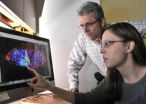(Press-News.org) In a series of studies involving 140 American men and women with liver tumors, researchers at Johns Hopkins have used specialized 3-D MRI scans to precisely measure living and dying tumor tissue to quickly show whether highly toxic chemotherapy – delivered directly through a tumor's blood supply – is working.
The investigators say their findings, to be presented March 22-27 in San Diego at the annual meeting of the Society of Interventional Radiology, are the first "proof of principle" that this technology can show tumors in three dimensions and accurately measure tumor viability and death. Early data was also presented at the Radiological Society of North America annual meeting, December 1-6 in Chicago.
They also say their results – in patients with either primary liver cancers or metastatic tumors from cancers originating elsewhere in the body -- are evidence that using this technology before and after treatment is a faster and better tool for predicting patient survival after chemotherapy targeted directly at tumors, called chemoembolization.
Unlike standard methods to assess tumor response after chemoembolization, which are based on two-dimensional images and tumor size, the Johns Hopkins-developed 3-D technology also distinguishes between dead and live tissue, giving an accurate assessment of tumor cell death.
The new technology builds on standard 2-D methods and uses computer analytics to evaluate the amount of so-called contrast dye absorbed by tumor tissue. The dye is injected into patients before their MRI scan to enhance image production. Researchers say live tissue will absorb more dye than dead tissue, affecting image brightness, which can also be measured for size and intensity.
"Our high-precision, 3-D images of tumors provide better information to patients about whether chemoembolization has started to kill their tumors so that physicians can make more well-informed treatment recommendations," says Johns Hopkins interventional radiologist Jean-Francois Geschwind, M.D., the senior investigator on the studies.
Geschwind, a professor in the Russell H. Morgan Department of Radiology at the Johns Hopkins University School of Medicine and its Kimmel Cancer Center, says that knowing the true extent of a tumor's response to chemoembolization is particularly important for patients with moderate to advanced stages of the disease, whose liver tumors might initially be too large or too numerous to surgically remove.
In the first study, researchers compared the standard imaging method and the newly developed technology in 17 Baltimore men and women with advanced liver cancer. All were treated with surgery or liver transplantation after chemoembolization. The research team used existing MR analysis techniques, as well as the new 3-D method to compare the radiologists' analyses with pathologic review of tumor samples after therapy and surgical removal. The error margin of the new 3-D image analysis, they say, was low (at up to 10 percent) when predicting the amount of dead tumor tissue found by pathologists whereas the standard, 2-D method deviated by as much as 40 percent from actual values.
In a series of additional studies, Geschwind and his team used the standard and new imaging techniques to analyze the MRI scans of more than 300 liver tumors in some 123 other men and women, also from the Baltimore region. All patients were treated at The Johns Hopkins Hospital between 2003 and 2012, and each received pre- and post-chemoembolization MRI scans to assess the effects of therapy on the tumors.
Using the new 3-D method method, Geschwind's team found that patients who responded well to therapy lived 19 months longer (an average of 42 months) than patients who did not respond well (average 23 month survival). Standard methods showed slightly less difference in survival (average 18 months longer) between patients who responded to therapy and those who did not respond.
Geschwind says the 3-D technology's improved accuracy removes a lot of the guesswork that now goes into evaluating treatment outcomes. The new assessment takes seconds to perform, he adds, so radiologists can provide faster, almost instantaneous treatment advice.
Geschwind and his team plan further software refinements to the new approach before training more physicians to use it. He also has plans to study how it can affect treatment decisions, and whether these therapy choices help people live longer.
The software used in the MRI scans was developed at Johns Hopkins and at Philips Research North America, in Briarcliff Manor, N.Y. Philips, whose parent company is based in the Netherlands, manufactures some of the MRI devices used in the study.
Liver cancer kills nearly 20,000 Americans each year, and is much more prevalent outside the United States, where it is among the top-three causes of cancer death in the world. Experts cite the rising numbers of hepatitis C infections, which cause chronic liver inflammation and are a leading risk factor for liver cancer.
INFORMATION:
Funding support for this study was provided by the French Society of Radiology and Philips Research North America. Additional funding support was provided by the National Cancer Institute, and the National Center for Research Resources, both members of the National Institutes of Health (R01 CA160771, P30 CA006973, and UL1 RR 025005), and the Rolf W. Günther Foundation for Radiology and Radiological Sciences.
In addition to Geschwind, Johns Hopkins scientists involved in the study were Julius Chapiro, M.D., Rafael Duran, M.D., Laura Wood, M.D., Ph.D., Vania Tacher, M.D., Toby Charles Cornish, M.D., Ph.D., Nikhil Bhagat, M.D., Constantine Frangakis, Ph.D., Hooman Yarmohammadi, M.D., Michael Chao, M.Sc., Rongxin Chen, M.D., Ph.D., Zhijun Wang, M.D., Ph.D., and Vivek Charu, M.D., Ph.D. Additional research assistance was provided by MingDe Lin, Ph.D., a Philips biomedical engineer based at Johns Hopkins who has been collaborating with Geschwind for the past seven years on the new technology.
Abstracts described in this news release include:
SIR abstracts:
1830145 Quantitative 3-D Volumetric Assessment of Tumor Response after Intra-arterial Therapy of Colorectal Cancer Metastases to the Liver - a new surrogate marker for survival;
Scientific Session TACE IV, Wednesday 3/26 - 1:39 PM - 1:48 PM, Room 16 A
1859360 Uveal Melanoma Metastatic to the Liver: the Role of Quantitative and Functional MR Imaging in the Assessment of Early Tumor Response after TACE;
Scientific Session TACE I, Sunday 3/23 - 2:42 PM - Room 16 A
1831150 Radio-pathological correlation of 3-D-quantitative contrast-enhanced and functional MRI in HCC patients after TACE- do we see what we treat?
Scientific Session TACE II, Monday 3/24 - 9:03-9:12 AM - Room 16 A
RSNA abstract:
SSSC16-07 Volumetric Tumor assessment Predicts Survival in Patients Treated with Transarterial Chemoembolization for Hepatocellular Carcinoma
For additional information, go to:
http://www.sirmeeting.org/
http://www.hopkinsmedicine.org/vascular/staff/physicians/geschwind.html
http://www.hopkinsmedicine.org/vascular/procedures/chemoembolization/
Media contacts:
Vanessa Wasta, 410-614-2916, wasta@jhmi.edu
Amy Mone, 410-614-2915, amone@jhmi.edu
JOHNS HOPKINS MEDICINE
Johns Hopkins Medicine (JHM), headquartered in Baltimore, Maryland, is a $6.7 billion integrated global health enterprise and one of the leading health care systems in the United States. JHM unites physicians and scientists of the Johns Hopkins University School of Medicine with the organizations, health professionals and facilities of The Johns Hopkins Hospital and Health System. JHM's mission is to improve the health of the community and the world by setting the standard of excellence in medical education, research and clinical care. Diverse and inclusive, JHM educates medical students, scientists, health care professionals and the public; conducts biomedical research; and provides patient-centered medicine to prevent, diagnose and treat human illness. JHM operates six academic and community hospitals, four suburban health care and surgery centers, more than 38 primary health care outpatient sites and other businesses that care for national and international patients and activities. The Johns Hopkins Hospital, opened in 1889, was ranked number one in the nation for 21 years by U.S. News & World Report.
3-D MRI scans may offer better way to predict survival after chemo for liver tumors
2014-03-26
ELSE PRESS RELEASES FROM THIS DATE:
Lawrence Livermore scientists discover bacterial resistance to improve biofuel production
2014-03-26
Resistance is not futile when it comes to a new method to more efficiently convert biomass to biofuels.
New research by scientists from Lawrence Livermore National Laboratory in conjunction with the Joint BioEnergy Institute (JBEI) suggests that a type of bacterial resistance may provide more efficient production of biofuels.
The team identified the genetic origin of bacterial resistance to an ionic liquid (a salt in the liquid state), which they successfully introduced into a strain of E. coli bacteria for the production of advanced biofuels. The ionic liquid resistance ...
Significant progress toward creating 'benchtop human' reported
2014-03-26
Significant progress toward creating "homo minutus" - a benchtop human -was reported at the Society of Toxicology meeting on Mar. 26 in Phoenix.
The advance - successful development and analysis of a liver human organ construct that responds to exposure to a toxic chemical much like a real liver- was described in a presentation by John Wikswo, the Gordon A. Cain University Professor and Director of the Vanderbilt Institute for Integrative Biosystems Research and Education (VIIBRE) at Vanderbilt University.
The achievement is the first result from a five-year, $19 million ...
UT Southwestern cancer biologists link tumor suppressor gene to stem cells
2014-03-26
DALLAS – March 26, 2014 – Just as archeologists try to decipher ancient tablets to discern their meaning, UT Southwestern Medical Center cancer biologists are working to decode the purpose of an ancient gene considered one of the most important in cancer research.
The p53 gene appears to be involved in signaling other cells instrumental in stopping tumor development. But the p53 gene predates cancer, so scientists are uncertain what its original function is.
In trying to unravel the mystery, Dr. John Abrams, Professor of Cell Biology at UT Southwestern, and his team ...
Biological testing tool, ScanDrop, tests in fraction of time and cost of industry standard
2014-03-26
Northeastern University professor of pharmaceutical sciences, Tania Konry, has developed a single instrument that can conduct a wide range of biological scans in a fraction of the time and cost of industry standard equipment. That's because it uses considerably less material and ultra-sensitive detection methods to do the same thing.
Currently, researchers face enormous time constraints and financial hurdles from having to run these analyses on a regular basis. Hundreds of dollars and 24 hours are what's required to scan biological materials for important biomarkers that ...
Natural history must reclaim its place
2014-03-26
Support in developed countries for natural history—the study of the fundamental nature of organisms and how and where they live and interact with their environment—appears to be in steep decline. Yet natural history provides essential knowledge for fields as varied as human health, food security, conservation, land management, and recreation. In the April issue of BioScience, a group of scientists from institutions across North America details examples supporting their conviction that a revitalization of the practice of natural history will provide important benefits for ...
Coal plant closure in China led to improvements in children's health
2014-03-26
Decreased exposure to air pollution in utero is linked with improved childhood developmental scores and higher levels of brain-derived neurotrophic factor (BDNF), a key protein for brain development, according to a study looking at the closure of a coal-burning power plant in China led by researchers at the Columbia Center for Children's Environmental Health at the Mailman School of Public Health.
The study is the first to assess BDNF and cognitive development with respect to prenatal exposure to polycyclic aromatic hydrocarbons (PAH), a component of air pollution commonly ...
Resistance is not futile
2014-03-26
Researchers with the U.S. Department of Energy (DOE)'s Joint BioEnergy Institute (JBEI), a multi-institutional partnership led by Berkeley Lab, have identified the genetic origins of a microbial resistance to ionic liquids and successfully introduced this resistance into a strain of E. coli bacteria for the production of advanced biofuels. The ionic liquid resistance is based on a pair of genes discovered in a bacterium native to a tropical rainforest in Puerto Rico.
"We identified two genes in Enterobacter lignolyticus, a soil bacterium that is tolerant to imidazolium-based ...
NASA catches Gillian as a super-cyclone before quickly dissipating
2014-03-26
VIDEO:
On March 23 when the TRMM satellite passed over Gillian, it was at hurricane-force. TRMM revealed intense storms in a well-defined eye wall producing rain at a rate of over...
Click here for more information.
Tropical Cyclone Gillian was near peak intensity when the Tropical Rainfall Measuring Mission or TRMM satellite passed overhead and saw towering thunderstorms and very heavy rainfall in the storm on March 23. By March 26, Gillian had weakened to a tropical storm and ...
Rice U. study: Don't shop for travel at work
2014-03-26
HOUSTON – (March 26, 2014) –It is probably not a good idea to shop for leisure travel from the office during business hours, according to a new study from Rice University and Iowa State University.
Using data from a major online hotel reservation site, the study examined the quality of the hotel that consumers chose for their vacations and subsequently how satisfied they were with their stay. They found that consumers who traveled farther and made reservations during business hours were more likely to select higher quality hotels but were less satisfied after their stay. ...
Dark energy hides behind phantom fields
2014-03-26
Quintessence and phantom fields, two hypotheses formulated using data from satellites, such as Planck and WMAP, are among the many theories that try to explain the nature of dark energy. Now researchers from Barcelona and Athens suggest that both possibilities are only a mirage in the observations and it is the quantum vacuum which could be behind this energy that moves our universe.
Cosmologists believe that some three quarters of the universe are made up of a mysterious dark energy which would explain its accelerated expansion. The truth is that they do not know what ...






